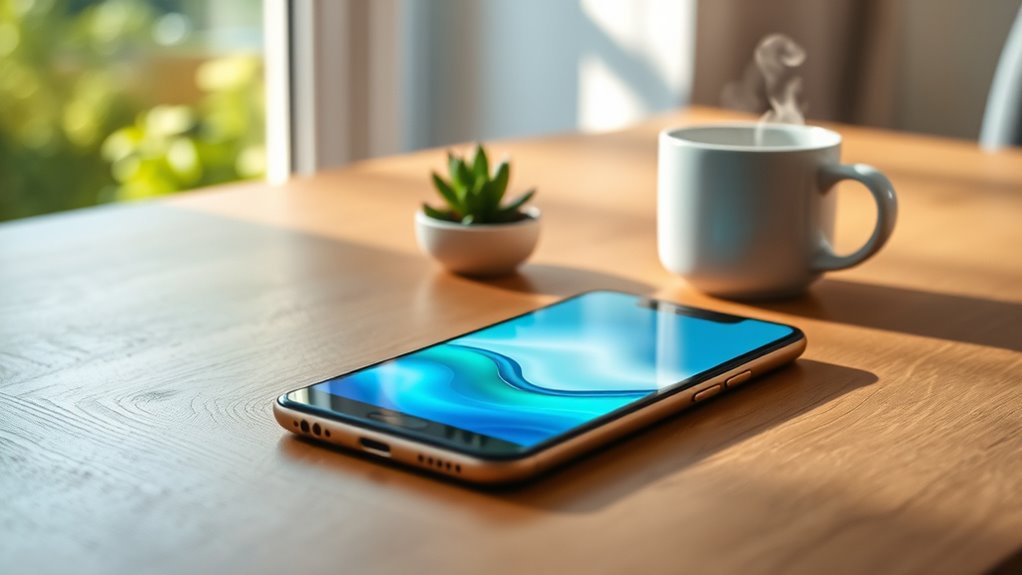To turn your phone into a calm companion, practice digital mindfulness by setting intentional boundaries around usage. Turn off non-essential notifications, choose calming apps, and pause before checking your device. Be aware of your emotional reactions and avoid mindless scrolling. Use your device as a tool for relaxation and focus, rather than stress. By creating mindful habits, you can transform your relationship with technology—continue exploring ways to cultivate calm with your phone.
Key Takeaways
- Turn off non-essential notifications to minimize distractions and create a peaceful device environment.
- Set specific, intentional times for phone use to foster mindful engagement.
- Choose calming apps for relaxation, meditation, or learning to promote tranquility.
- Practice pausing before phone use to assess genuine needs, reducing impulsive checking.
- Adjust device settings, like enabling dark mode or reducing refresh rates, to enhance visual calmness.

Have you ever felt overwhelmed by the constant stream of notifications and digital noise? It’s easy to get caught up in the endless scroll, feeling like your device controls your attention instead of the other way around. This pattern often leads to tech addiction, where the urge to check your phone becomes compulsive, pulling you away from the present moment. But there’s a way to reclaim your digital space and turn your phone into a calm companion—by practicing digital mindfulness. The key is to approach your device with intentionality, adopting mindful browsing habits that help you stay centered rather than distracted.
Start by setting clear boundaries around your device usage. Instead of mindlessly reaching for your phone whenever you have a free moment, pause and ask yourself if you genuinely need to check it. Are you seeking information or just scrolling out of habit? When you do browse, do so with purpose. Choose specific times for checking emails, social media, or news, and stick to those windows. This deliberate approach reduces the temptation to indulge in mindless scrolling, which often fuels tech addiction. As you become more aware of your habits, you’ll notice how much more control you have over your digital life.
Set clear boundaries and browse with purpose to regain control over your digital habits.
Practicing mindful browsing also involves paying close attention to how your devices make you feel. Notice when you start to feel anxious, distracted, or overwhelmed. Recognize these feelings without judgment and take a moment to breathe. This awareness can help you break the cycle of compulsive checking and foster a healthier relationship with technology. Instead of letting your phone dictate your mood, use it as a tool for calm and focus. For example, choose apps that promote relaxation, meditation, or learning, and limit your exposure to content that triggers stress or distraction.
Another helpful tip is to turn off non-essential notifications. When your phone constantly buzzes or pings, it pulls you out of the present and fuels tech addiction. By silencing unnecessary alerts, you create space for mindful browsing—where you’re in control of your attention rather than being pulled in multiple directions. Additionally, understanding how high refresh rates can impact your gaming and viewing experience may help you select devices that suit your needs better. Over time, this practice encourages a more intentional, peaceful use of your device. Remember, your phone can be a source of calm rather than chaos if you approach it with mindfulness. The goal isn’t to eliminate technology but to integrate it thoughtfully into your life, making it a tool that supports your well-being instead of draining it.
Frequently Asked Questions
How Can I Start Practicing Digital Mindfulness Effectively?
To start practicing digital mindfulness effectively, you should set clear boundaries for your screen time. Begin with mindfulness meditation to increase awareness of your digital habits. Incorporate regular digital detox periods, where you disconnect completely. Use your phone intentionally, avoiding mindless scrolling. Over time, you’ll develop a healthier relationship with technology, reducing stress and enhancing focus. Consistency is key—start small, stay committed, and watch your digital mindfulness grow.
What Are the Best Apps for Digital Mindfulness?
You seek the best apps for digital mindfulness, so explore options that guide mindfulness meditation, support digital detoxes, and promote calmness. Apps like Headspace, Calm, and Insight Timer offer guided meditation sessions and mindfulness exercises to help you stay present. They encourage regular practice, assist you in disconnecting from screens, and foster mental clarity. By integrating these apps into your routine, you turn your phone into a tool for peace, focus, and well-being.
How Does Digital Mindfulness Improve Mental Health?
Digital mindfulness improves your mental health by helping you practice mindfulness meditation, which reduces stress and anxiety. When you become more aware of your digital habits, you gain mental clarity and control over your screen time. This intentional approach encourages healthier interactions with your devices, fostering a calmer mind. As a result, you experience better mood, focus, and overall well-being, making digital mindfulness a valuable tool for mental health.
Can Digital Mindfulness Reduce Screen Time?
You can reduce your screen time by practicing digital mindfulness, which encourages mindful notifications and intentional device use. By turning off non-essential alerts, you avoid constant distractions and become more aware of your habits. Incorporate regular digital detoxes to disconnect fully and reset your focus. This mindful approach helps you regain control over your screen time, making your interactions with technology more intentional and less overwhelming.
What Are Common Challenges When Adopting Digital Mindfulness?
Like battling a tidal wave, adopting digital mindfulness presents challenges. You might struggle with tech addiction, finding it hard to disconnect from your devices. Notification fatigue can make you feel overwhelmed, constantly craving updates. Staying consistent is tough, especially when habits are deeply ingrained. Overcoming these hurdles requires patience, intention, and a willingness to reset your relationship with technology, turning your device into a tool for calm rather than chaos.
Conclusion
By practicing digital mindfulness, you can transform your phone into a calming tool rather than a source of stress. Did you know that the average person spends over 3 hours a day on their phone? Imagine how much calmer and more focused you’d feel if you used just a fraction of that time mindfully. Start small—pause, breathe, and reconnect with the present. Your mental well-being will thank you for turning your device into a calming companion.









